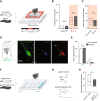Internal state affects local neuron function in an early sensory processing center to shape olfactory behavior in Drosophila larvae
- PMID: 36131078
- PMCID: PMC9492728
- DOI: 10.1038/s41598-022-20147-1
Internal state affects local neuron function in an early sensory processing center to shape olfactory behavior in Drosophila larvae
Abstract
Crawling insects, when starved, tend to have fewer head wavings and travel in straighter tracks in search of food. We used the Drosophila melanogaster larva to investigate whether this flexibility in the insect's navigation strategy arises during early olfactory processing and, if so, how. We demonstrate a critical role for Keystone-LN, an inhibitory local neuron in the antennal lobe, in implementing head-sweep behavior. Keystone-LN responds to odor stimuli, and its inhibitory output is required for a larva to successfully navigate attractive and aversive odor gradients. We show that insulin signaling in Keystone-LN likely mediates the starvation-dependent changes in head-sweep magnitude, shaping the larva's odor-guided movement. Our findings demonstrate how flexibility in an insect's navigation strategy can arise from context-dependent modulation of inhibitory neurons in an early sensory processing center. They raise new questions about modulating a circuit's inhibitory output to implement changes in a goal-directed movement.
© 2022. The Author(s).
Conflict of interest statement
The authors declare no competing interests.
Figures





References
-
- Torres JB, Evangelista WS, Jr, Barras R, Guedes RNC. Dispersal of Podisus nigrispinus (Het., Pentatomidae) nymphs preying on tomato leafminer: Effect of predator release time, density and satiation level. J. Appl. Entomol. 2002;126:326–332. doi: 10.1046/j.1439-0418.2002.00653.x. - DOI
-
- Bell WJ. Searching behavior patterns in insects. Annu. Rev. Entomol. 1990;35:447–467. doi: 10.1146/annurev.en.35.010190.002311. - DOI
-
- Jones RE. Search behaviour: A study of three caterpillar species. Behaviour. 1977;60:237–259. doi: 10.1163/156853977X00225. - DOI
Publication types
MeSH terms
Substances
Grants and funding
LinkOut - more resources
Full Text Sources
Medical
Molecular Biology Databases

